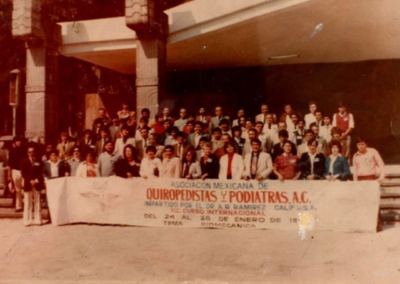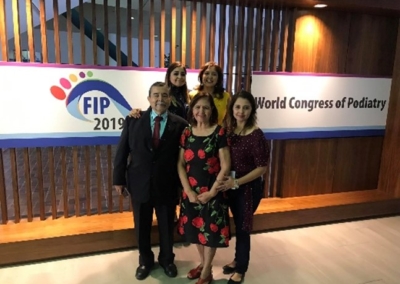In the dynamic realm of Mexican podiatry, the García family serves as a cornerstone of continuity and progress, spanning five generations since 1900. Their influence has been transformative in the field, from the early days in public baths during the Mexican Revolution to establishing the Gama clinic and spearheading the first university-level podiatry school in the northern region.
Recently, two members of the García family, Dulce Garcia, and Judith Guzman, took a leap forward by undertaking a residency with ALPS Founding President, Dr. David Armstrong, and his program at the Southern Arizona Limb Salvage Alliance (SALSA). This hands-on experience with Dr. Armstrong not only underscores the family’s commitment to staying at the forefront of podiatric advancements but also aligns with their mission to elevate podiatry education in Mexico. Our interview with Dulce delves into the pragmatic aspects of this collaboration, shedding light on how it positions the García family as leaders in the ever-evolving landscape of podiatric care while highlighting the invaluable insights gained from their time with Dr. Armstrong:
ALPS: What made you decide to become a podiatrist?
Dulce: I chose to become a podiatrist due to a rich family history dating back to Mr. Agustin García during the Mexican Revolution. The legacy of foot care and its evolution over generations inspired me to continue the tradition. Witnessing the increasing prevalence of diabetes and related foot issues in Mexico, particularly in our region, fueled my commitment to contribute to the field.
ALPS: Tell us a little about your background information about your family’s podiatry school and clinic.
Dulce: Our family’s podiatry journey led to the establishment of the Gama clinic, initiated by my father, Mr. Juan Manuel García, in 1967. Located in Torreón, the clinic has evolved from its early roots in public baths during the Mexican Revolution. In 2021, we realized our dream of launching a university-level podiatry school, with classes starting in September and eight students enrolled. The challenges our community faces include the rising prevalence of diabetes and associated foot complications.
ALPS: What have you learned so far during your residency at USC?
Dulce: During my residency at USC/SALSA, I gained valuable insights into the research process, witnessing the deficiencies in our healthcare system, not only in Mexico but also across Latin America. I was impressed by the collaborative approach among different hospitals, all working towards finding solutions. The management of ulcers, with its diverse treatments like patches, antibiotic pearls, and simple solutions like dressings, was particularly enlightening. Dr. Armstrong’s humane approach to patients, despite a busy schedule, and his emphasis on team importance left a lasting impression.
ALPS: What are the aspects of your residency that you will take back to your school and clinic? How can those aspects help you face the challenges you see at your practice?
Dulce: Taking these experiences back to my school and clinic, I aim to implement USC/SALSA’s research protocols locally, strengthening our multidisciplinary system and encouraging future generations to engage in research. Establishing an official algorithm for limb salvage with our multidisciplinary team is also a goal, unifying patient care and promptly identifying those at high risk for ulcer formation.
ALPS: Why do you think organizations like ALPS, that foster interdisciplinary teamwork and inspire students like yourself to act against amputations, are so important?
Dulce: Organizations like ALPS, fostering interdisciplinary teamwork and inspiring action against amputations, are crucial. Limb salvage shouldn’t rely on a single doctor but a multidisciplinary team offering diverse knowledge and treatments for comprehensive patient care. ALPS plays an indispensable role in promoting foot management globally, uniting advancements and research to broaden treatment options. Our experience is a testament to their impactful influence, motivating us to continue the mission.
To get more information about the INEDLA and GAMA Clinic in Torreón, visit their Facebook page or contact them via email at contacto@inedla.mx.



